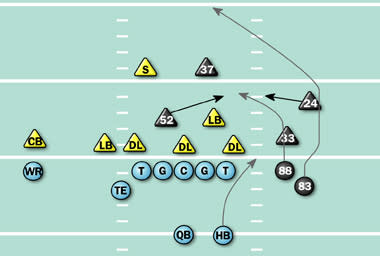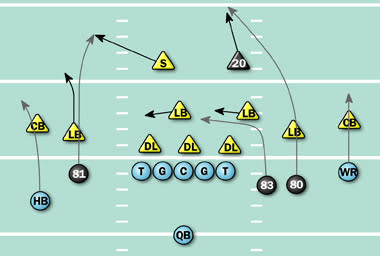Dolphins pass D must minimize big plays
Also in this article:
Next Surveillance:
Steelers
More NFL:
Editor's note: Yahoo! Sports will examine the biggest weakness of the 2009 season for every team and explain how the franchise can address the issue. The series continues with the Dolphins, who finished third in the AFC East (7-9).
Biggest problem in 2009: Too many big plays allowed

Tony Sparano's Dolphins had a disappointing 7-9 record in 2009.
(Sam Greenwood/Getty Images)
After a franchise-worst 1-15 season in 2007, nobody expected much from the Miami Dolphins in 2008. But a new-look team – run by head of football operations Bill Parcells and coach Tony Sparano, and fueled by the Wildcat – shocked the league and won the AFC East. A seven-win follow-up season was a real disappointment as the Patriots and Jets established themselves as the division's big kids in 2009. If the Dolphins wish to reclaim the division, they'll have to shore up a worrisome tendency of their defense allowing big plays. In 2009, only the Raiders and Browns gave up a higher percentage of receptions 20 yards or longer than the Dolphins' 11.66 percent (57 plays in 489 attempts), and only the Raiders gave up a higher percentage of pass plays 40 yards or longer than Miami's 3.48 percent (17 plays). That's disturbing stuff for a defensive-minded executive like Parcells, especially when his new team got lit up the most by one of his old teams. Three of those 17 bombs came in a Week 13 home game against the Patriots: one to the left, one to the right, and one right up the middle of the field. But it was the 58-yard pass to Wes Welker(notes) in the second quarter that must have driven Parcells nuts. Welker is known as anything but a deep threat, but he beat three Dolphins defenders downfield in a way that would have made Randy Moss(notes) proud.

Figure 1
With 3:53 left in the first half and the Pats up, 14-7, New England had the ball on its own 27-yard line with third-and-6. They lined up in shotgun with three receivers, with Welker (83) and Sam Aiken(notes) (88) in a tight twins right formation (Fig. 1). At the snap, Aiken took cornerback Vontae Davis(notes) (24) and linebacker Channing Crowder(notes) (52) out with a short slant, while Welker went with a deep post, beating cornerback Nate Jones (33) at the turn. Safety Yeremiah Bell(notes) (37) was playing center field, but he bit on the inside route to Aiken which gave Welker the separation he needed upfield. By the time Jones and Bell recovered, Welker was in transit, and Tom Brady(notes) once again targeted his favorite receiver. The genius of the route Welker ran was in the hard cut he made after running a few steps outside – he made the defense think he was coming back up for a short slant and then ran the post. Miami's relative positional inexperience – Davis was a rookie, Jones is more of a nickel defender and Bell is less a center fielder and more a tackling machine – exacerbated the problem and gave the Dolphins no real defense against the subtleties of Welker's game.
The 2010 solution: Use positional stability to promote assignment-correct play
New Dolphins defensive coordinator Mike Nolan will have a lot to say about how the defense changes in 2010. When he engineered a great turnaround for the Broncos last season, Nolan had two pass defenders in Champ Bailey(notes) and Brian Dawkins(notes) who have forgotten more about the game than the new kids in Miami have learned. Still, some concepts are universal, and we can get a handle on how things might change by looking at how Nolan's Denver defense stopped the Patriots from running off any big plays in a Week 5 win. The 2009 Broncos allowed just five pass plays of 40 yards or more, and none against New England. That doesn't mean that Brady didn't try to make it happen.

Figure 2
With 10:25 left in the game, the Patriots had second-and-7 at the Denver 47, and Brady went for the home run. But the Broncos were sound in their coverage as halfback Kevin Faulk(notes) motioned wide left; the defenders switched their assignments seamlessly and matched the spread set of the offense (Fig. 2). Moss (81) ran a deep route that took the deep safety off the middle, and Welker took both inside linebackers out with a shallow cross. The wild card in this play was reserve tight end Michael Matthews(notes), who was lined up outside Welker. Again, the idea was to try and fool the defense by sending a player more suited for short routes on a deep post. But this time, Dawkins (20) refused to bite on the deep route to Moss or the short stuff to Welker – he followed Matthews straight up the middle and deflected the ball away at the end zone before Mitchell could catch it.
The element of surprise was taken away, replaced by a route that didn't work in part because the receiver wasn't fast enough to get downfield before the ball was thrown. This time, the deception was Denver's. Dawkins is known as a safety who lacks the downfield speed to make that play, but unlike Bell, he stayed with his assignment and therefore had the advantage. Now, the advantage will be Miami's as Nolan impresses these concepts on his new charges.
